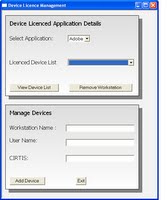The following details the per user (HKCU) registry keys that manage the file associations for various office viewer products.
Setting these registry keys at a per User basis allows the delivery of office viewer software to certain users within the environment (eg. users with no licence)
Microsoft Word Viewer File Associations HKCU\software\Classes\.dot\","Wordview.document.8","REG_SZ
HKCU\software\Classes\.dot\Content Type","application/vnd.openxmlformats-officedocument.wordprocessingml.document","REG_SZ
HKCU\software\Classes\.dot\PerceivedType","Document","REG_SZ
HKCU\software\Classes\.docx\","Wordview.document.8","REG_SZ
HKCU\software\Classes\.docx\OpenWithList","Wordview.exe","REG_SZ
HKCU\software\Classes\.doc\","Wordview.document.8","REG_SZ
HKCU\software\Classes\.doc\OpenWithList","wordview.exe","REG_SZ
HKCU\software\Classes\.rtf\","Wordview.RTF.8","REG_SZ
HKCU\software\Classes\.rtf\Content Type","application/msword","REG_SZ
HKCU\software\Classes\.rtf\OpenWithList","wordview.exe","REG_SZ
HKCU\software\Classes\.rtf\OpenWithList\ShellNew\Data","{\rtf1}","REG_SZ
HKCU\software\Classes\.docm\","Wordview.document.8","REG_SZ
HKCU\software\Classes\.docm\Content Type","application/vnd.ms-word.document.macroEnabled.12","REG_SZ
HKCU\software\Classes\.docm\PerceivedType","Document","REG_SZ"
Microsoft Excel Viewer File Associations "HKCU\software\Classes\.xls\","ExcelViewer.Sheet.8","REG_SZ"
"HKCU\software\Classes\.xls\","ExcelViewer.Sheet.8","REG_SZ"
Microsoft PowerPoint Viewer File Associations
"HKCU\software\Classes\.ppt\","PowerPointViewer.Show.12","REG_SZ"
"HKCU\software\Classes\.pptm\","PowerPointViewer.ShowMacroEnabled.12","REG_SZ"
"HKCU\software\Classes\.pps\","PowerPointViewer.SlideShow.12","REG_SZ"
"HKCU\software\Classes\.ppsx\","PowerPointViewer.SlideShow.12","REG_SZ"
"HKCU\software\Classes\.ppsm\","PowerPointViewer.SlideShowMacroEnabled.12","REG_SZ"
"HKCU\software\Microsoft\PowerPoint Viewer\12.0\EULAAccepted","1","REG_DWORD"
Microsoft Visio Viewer File Associations"HKCU\software\Classes\.vsd\","VisioViewer.Viewer","REG_SZ"
"HKCU\software\Classes\.vsd\Content Type","application/vnd.ms-visio.viewer","REG_SZ"
"HKCU\software\Classes\.vss\","VisioViewer.Viewer","REG_SZ"
"HKCU\software\Classes\.vss\Content Type","application/vnd.ms-visio.viewer","REG_SZ"
"HKCU\software\Classes\.vst\","VisioViewer.Viewer","REG_SZ"
"HKCU\software\Classes\.vst\Content Type","application/vnd.ms-visio.viewer","REG_SZ"
"HKCU\software\Classes\.vdx\","VisioViewer.Viewer","REG_SZ"
"HKCU\software\Classes\.vdx\Content Type","application/vnd.ms-visio.viewer","REG_SZ"
"HKCU\software\Classes\.vsx\","VisioViewer.Viewer","REG_SZ"
"HKCU\software\Classes\.vsx\Content Type","application/vnd.ms-visio.viewer","REG_SZ"
"HKCU\software\Classes\.vtx\","VisioViewer.Viewer","REG_SZ"
"HKCU\software\Classes\.vtx\Content Type","application/vnd.ms-visio.viewer","REG_SZ"







